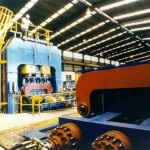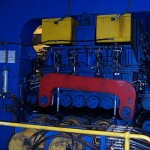Heavy Plate Leveller
Bisalloy Steels manufactures steel plate of high hardness and strength using a quench and temper process. A degree of warping of the steel plate occurs during this process, and during the mid 1990s Bisalloy was seeing a threat to their business due to customers wanting flatter, high tensile plates.
Completed during 1997 and 1998, CMA designed and built a fully automated heavy plate leveller, able to roll plates ranging from 5mm all the way through to 32mm/ 1600MPa. CMA was chosen for this project as our budget for the project was less than a 3rd of the cost of buying a suitable new machine. The starting point was to find a decommissioned leveller that could be purchased, so the rolls and housings could be used as the starting point for Bisalloy’s new machine.
World Wide Search.
A wide ranging search and inspection of a number of decommissioned levellers was carried out, and a suitable machine found in Britain. The previous owners were skeptical, pointing out it had struggled to roll 12.7mm mild steel when in use.
Redesign Project.
The leveller project involved a number of very substantial engineering exercises:-
- Mechanical Redesign. Roll and housing forces would increase by a factor of 10 to roll Bisalloy’s product range, so all aspects of the leveller’s structure and mechanical components ha d to be assessed in detail, and modified where necessary. Bearing changes, special concrete foundation design, and structural modifications were made.
- Individual Roll Drives. To overcome the common leveller problem of drive failures due to small speed mismatches between rolls, individual hydraulic roll drives were fitted to each work roll.
- Hydraulic Gauge Control. Due to the large forces and resulting housing stretch, along with the signficant variations on a daily basis of the product being rolled, a long-stroke hydraulic gauge control (roll gap control) system was designed and fitted to the machine. This system comprises 4 off 550mm bore x 200mm stroke hydraulic cylinders, along with servo valves and controls to allow roll gap, roll load, and torsional load through the housing to all be controlled.
- Dual Roll Cassettes. Bisalloy’s requirement was that all plates in their range from 5 to 32mm be rolled in the leveller. The only way to roll the thicker plates was to use a different set of rolls, with 2 top rolls and 3 bottom rolls, and with double roll spacing as compared with the initial 4 over 5 roll set. A quick change mechanism was fitted to allow rolls to be swapped multiple times daily to suit the production schedule.
- High Power efficiency. Due to the location of Bisalloy’s plant, local power authorities limited the additional power consumption to 300kW for the project. This was quite a challenge, and was met by designing a central hydraulic system that used electronic load sensing control, to ensure oil at the correct flow and pressure was provided at any one time, rather than the conventional method of supplying at a constant pressure and throttling for lower loads.
Long Term Performance and Reliability
For approaching 10 years the leveller has been operating with few problems and no significant outages. Roll cassettes are mechanically overhauled every 2 years, and hydraulic audits are carried out every 12 months.
Contrary to the original owner’s fears, there have been no mechanical or structural failures, and the proportional of Bisalloy plates meeting flatness specifications has risen from 60-70% in 1996 to over 95% ever since.

